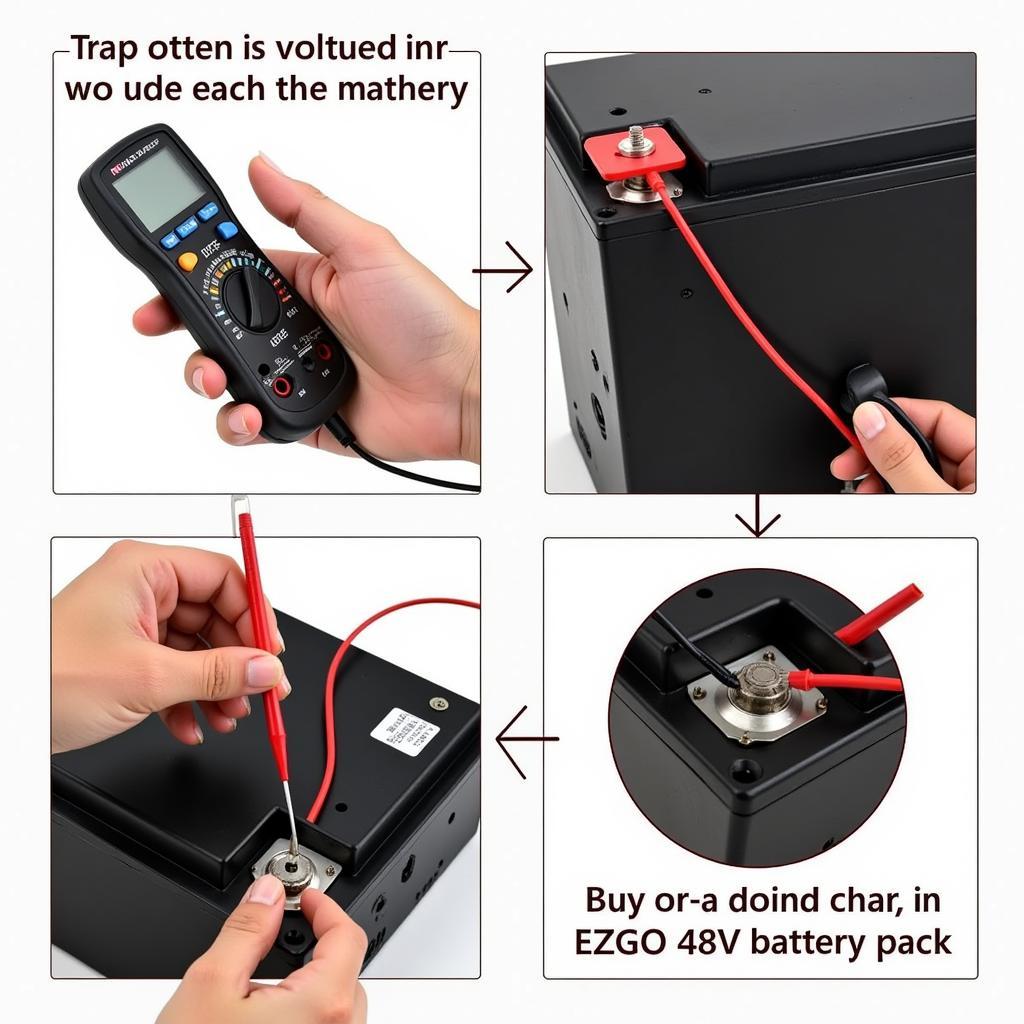Troubleshooting your EZGO 48 volt battery charger can be frustrating, but with a systematic approach, you can often pinpoint the issue and get back on the course. This guide provides a step-by-step approach to diagnosing and resolving common problems with your EZGO golf cart charger.
Understanding Your EZGO 48 Volt Charger
Before diving into troubleshooting, it’s crucial to understand the basic operation of your EZGO 48 volt charger. These chargers are designed to deliver a controlled current to your golf cart’s batteries, replenishing their charge after use. A typical charging cycle involves several stages, from initial bulk charging to the final float charge that maintains the battery’s full capacity. Familiarizing yourself with these stages can help you identify where a problem might be occurring. Is the charger clicking on and off repeatedly? Is it not reaching the float stage? These are telltale signs of potential issues.
Common EZGO 48 Volt Battery Charger Problems
Several common problems plague EZGO 48 volt chargers. Understanding these issues can streamline your troubleshooting process. Some frequent culprits include faulty wiring, blown fuses, damaged charging cables, and malfunctioning internal components within the charger itself. Less frequently, the problem might lie with the batteries themselves, not the charger.
Checking the Obvious: Power Supply and Connections
The first step in troubleshooting your EZGO 48 volt battery charger is to verify the power supply. Ensure the outlet you’re using is functioning correctly. Test it with another device, or use a voltage tester to confirm the presence of voltage. Next, check all connections. Loose or corroded connections can disrupt the flow of electricity and prevent the charger from working correctly.
 Checking EZGO 48V Charger Connections
Checking EZGO 48V Charger Connections
Delving Deeper: Fuses and Internal Components
If the power supply and connections are sound, the next step is to check the fuses. Locate the fuse(s) on your EZGO 48 volt battery charger and inspect them for any signs of damage. A blown fuse will have a broken filament. Replace any blown fuses with the correct amperage rating. If the fuses are intact, the problem might reside within the charger’s internal components. This requires more advanced troubleshooting and might necessitate professional assistance.
“Checking the fuses is a simple yet crucial step in troubleshooting any electrical issue,” advises John Miller, Senior Electrical Technician at CartCare Solutions. “A blown fuse often indicates a short circuit or overload, protecting the charger and batteries from further damage.”
Battery Health: A Potential Culprit
Sometimes, the issue isn’t with the charger at all, but with the batteries. A faulty battery can prevent the charger from functioning correctly. Test each battery individually using a multimeter to ensure they are holding a charge. If a battery is failing, it will need to be replaced.
 Testing EZGO 48V Batteries with a Multimeter
Testing EZGO 48V Batteries with a Multimeter
Advanced Troubleshooting with Remote Diagnostics
In today’s technologically advanced world, remote diagnostics and software updates offer an efficient way to troubleshoot and resolve complex issues with your EZGO 48 volt battery charger. Specialized software allows technicians to access the charger’s internal systems, analyze data logs, and identify problems remotely. This often eliminates the need for costly and time-consuming on-site visits. Furthermore, remote software updates can address bugs and optimize the charger’s performance, extending its lifespan.
“Remote diagnostics has revolutionized the way we troubleshoot electric vehicles,” says Sarah Chen, Lead Software Engineer at EV Diagnostics Inc. “We can now diagnose and resolve problems quickly and efficiently, saving our customers time and money.”
Conclusion: Mastering EZGO 48 Volt Battery Charger Troubleshooting
Troubleshooting your EZGO 48 volt battery charger doesn’t have to be daunting. By following these steps, you can often identify the problem and implement a solution. Remember to check the power supply, connections, fuses, and batteries. For more complex issues, consider the benefits of remote diagnostics and software updates. With a little patience and the right approach, you’ll have your EZGO golf cart back in action in no time.
FAQ: EZGO 48 Volt Battery Charger Troubleshooting
-
What is the most common cause of EZGO 48 volt charger problems? Loose or corroded connections are frequently the culprit.
-
How can I test my EZGO batteries? Use a multimeter to check the voltage of each battery individually.
-
What should I do if my EZGO charger is clicking on and off? This could indicate a faulty connection, blown fuse, or problem with the batteries.
-
Can I use a different charger for my EZGO 48 volt golf cart? It’s crucial to use a charger specifically designed for your EZGO model to avoid damaging the batteries.
-
What are the benefits of remote diagnostics for my EZGO charger? Remote diagnostics can quickly identify complex issues and facilitate software updates, saving time and money.
-
How can I prevent future problems with my EZGO 48 volt charger? Regularly inspect and clean the connections, keep the charger in a dry location, and avoid overcharging the batteries.
-
Where can I find professional help for my EZGO charger problems? Contact a qualified golf cart technician or authorized EZGO dealer for assistance.


